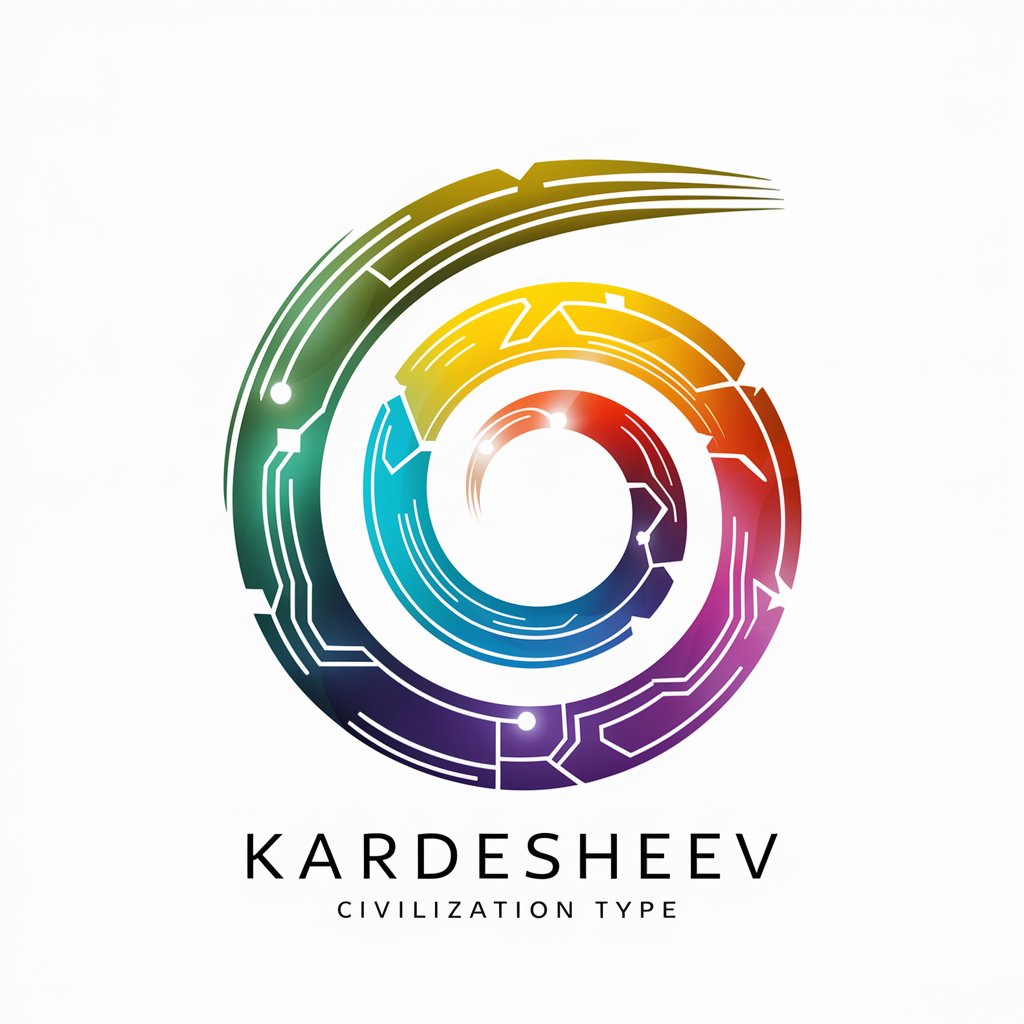Kardeshev Civilization Guide - advanced civilization analysis

Welcome! Explore the future of civilizations with me.
Explore Civilizations with AI
Tell me about Kardeshev Civilization Type I.
How does a Type II civilization harness energy?
What distinguishes a Type III civilization?
Explain the concept of a Type IV civilization.
Get Embed Code
Overview of Kardeshev Civilization Guide
The Kardeshev Civilization Guide is an interactive platform designed to explore and educate about the Kardeshev Scale—a method of measuring a civilization's level of technological advancement based on the amount of energy it is able to use. Initially proposed by Russian astrophysicist Nikolai Kardeshev in 1964, the scale has been expanded in this guide to include six types of civilizations, from Type I, which harnesses the energy available on its home planet, to Type VI, which manipulates the energy of the multiverse. The guide provides detailed explanations, visualizations, and hypothetical scenarios that help users understand each civilization type's characteristics, technological needs, and theoretical energy consumption. Powered by ChatGPT-4o。

Core Functions of Kardeshev Civilization Guide
Educational Content Delivery
Example
Explaining the energy usage and technological requirements for a Type II civilization, which is capable of harnessing all the energy output of its star, such as building and maintaining a Dyson Sphere.
Scenario
A high school science teacher uses the guide to prepare a lesson plan on advanced theoretical astrophysics, helping students visualize and understand high-level scientific concepts through interactive content and images.
Interactive Learning
Example
Providing a visual simulation of a Dyson Swarm versus a Dyson Sphere, illustrating the differences in construction, energy capture, and maintenance.
Scenario
A university student studying astrophysics uses the simulations to understand the practical challenges and theoretical implications of megastructures in space for a research paper.
Scenario Building
Example
Generating hypothetical scenarios where civilizations transition from Type I to Type II, discussing the socio-political, economic, and environmental challenges involved.
Scenario
A science fiction writer explores these transitions to create a realistic backdrop for a novel, drawing on detailed descriptions and theoretical models provided by the guide.
Target User Groups for Kardeshev Civilization Guide
Educators and Students
This user group benefits immensely from the guide's detailed explanations and visual aids which are perfect for enhancing curricula and providing a deep dive into complex astrophysical concepts in an accessible way.
Science Fiction Writers
Writers find the guide valuable for building scientifically plausible worlds in their stories, helping them to weave intricate narratives that are both engaging and credible based on theoretical science.
Astrophysics Enthusiasts
Hobbyists and amateur astronomers use the guide to expand their knowledge and engage with cutting-edge scientific theories in a structured and interactive manner.

Guide to Using the Kardeshev Civilization Guide
Step 1
Access yeschat.ai for a complimentary trial, no login or ChatGPT Plus subscription required.
Step 2
Select a Kardeshev Type from I to VI to begin exploring the different levels of civilization based on their energy usage.
Step 3
Choose a topic of interest within the selected civilization type to receive detailed explanations and context.
Step 4
Request visual aids for complex concepts to enhance understanding through illustrative examples.
Step 5
Explore related topics suggested by the guide to deepen your knowledge about advanced civilizations and their technological possibilities.
Try other advanced and practical GPTs
Date Challenge
Master Omiai Etiquette with AI

Career LaunchPad GPT
Empower Your Job Search with AI

Agents
Unlock insights with AI-powered experts.

Tech Advisor(한글버전)
Empowering Tech Decisions with AI

SF Admin Helper
Empowering Salesforce Success with AI

Efficient Admin
Streamlining Admin with AI

Ashkhara Engineer
Revolutionizing Construction Management with AI

Building Insurance | Business Property insurance
Empowering your business with AI-driven insurance solutions.

Conveyance AI
Streamlining Conveyancing with AI

Portrait Creator(似顔絵クリエイター)
Craft Your Digital Likeness with AI

Copywise
Crafting Tomorrow's Copy Today

Settle In Buddy
Navigate Your Move with AI

Frequently Asked Questions About the Kardeshev Civilization Guide
What is the Kardeshev Civilization Guide?
The Kardeshev Civilization Guide is an interactive tool designed to explore the energy consumption and technological advancement levels of civilizations, categorized from Type I to VI. It offers detailed insights and visual aids to help users understand the theoretical framework of these classifications.
How can this guide assist in academic research?
This guide provides comprehensive descriptions, historical contexts, and scientific extrapolations useful for academic papers or research projects focusing on astrobiology, astronomy, and futuristic technologies.
What visual aids can I request?
Users can request illustrations and diagrams that explain the energy harnessing methods and technological capabilities of different Kardeshev Types, enhancing the learning experience.
Can the guide suggest topics for further exploration?
Yes, based on user interest and previous inquiries, the guide intelligently suggests related topics, encouraging a deeper and more comprehensive study of advanced civilizations.
Is there a limit to the number of sessions or questions?
No, users can explore the guide without any restrictions on the number of sessions or questions, making it a valuable resource for continuous learning and discovery.
